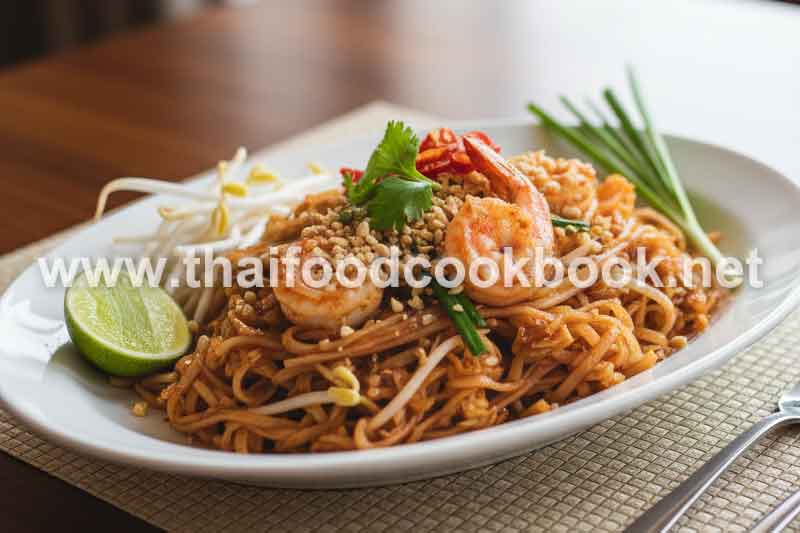Thai Red Curry with Shrimp – Restaurant-Style Recipe
Craving the bold flavors of a Thai restaurant at home? Many home cooks struggle to replicate the rich, creamy, spicy, and slightly sweet balance of Thai red curry with shrimp. Sometimes the curry turns out too thin, too bland, or the shrimp overcooked and rubbery. In this article, we’ll share a step-by-step, restaurant-style Thai red curry with shrimp recipe designed to help you overcome those pitfalls — from getting the perfect curry sauce texture to timing the shrimp just right. Whether you’re a beginner or an experienced cook, this guide ensures you get a vibrant and flavorful result every time, and we also address common mistakes along the way. For more Thai one-dish inspirations, see Thai one-dish menu ideas.
Understanding the Essence of Thai Red Curry with Shrimp
Before we begin cooking, it’s helpful to understand what makes Thai Red Curry with Shrimp such a beloved dish around the world. This curry perfectly blends creamy coconut milk, spicy red curry paste, and tender shrimp into a rich, aromatic sauce that’s both comforting and exciting. Each ingredient plays an important role — from the sweetness of coconut milk to the heat of chili and the freshness of herbs like basil and lime. In the sections below, you’ll learn how to bring these flavors together harmoniously to create an authentic restaurant-style curry right in your own kitchen.
Ingredients for Restaurant-Style Thai Red Curry with Shrimp
To make an authentic, rich, and balanced curry, gather fresh ingredients and quality components:
- **Shrimp**: 400 g (about 14 oz), peeled, deveined, tails on or off depending on preference
- **Thai red curry paste**: 2–3 tbsp (adjust to your spice tolerance)
- **Coconut milk**: 1 can (≈ 400 ml), preferably full-fat for creaminess
- **Vegetables & aromatics**:
- 1 small onion, thinly sliced
- 3–4 cloves garlic, minced
- 1 thumb-sized piece of fresh ginger (or galangal), finely grated
- 1 red bell pepper, sliced (optional)
- 1 zucchini or bamboo shoots (optional)
- Kaffir lime leaves, torn (optional, but authentic)
- **Seasonings & supporting liquids**:
- 1 tbsp fish sauce (or to taste)
- 1 tbsp palm sugar or brown sugar
- Juice of 1 lime
- Fresh Thai basil or cilantro (for garnish)
- Water or light broth (if needed to adjust consistency)
- Cooking oil (1–2 tbsp, e.g. coconut oil or neutral vegetable oil)
- Steamed jasmine rice or rice to serve with curry
Step-by-Step Instructions: How to Make Thai Red Curry with Shrimp
- Prep all ingredients first: peel and devein shrimp, slice onion, mince garlic and ginger, slice vegetables, tear kaffir lime leaves, and measure coconut milk and seasonings.
- Fry curry paste in coconut cream:
- Open the coconut milk can and scoop off 2–3 tbsp of the thick cream. In a pan over medium heat, melt that cream with a bit of oil until it begins to bubble and separate slightly.
- Add the red curry paste. Stir and fry for 1–2 minutes until fragrant, letting it “bloom” in the fat.
- Add aromatics and vegetables:
- Add onion, garlic, ginger (or galangal), and kaffir lime leaves; stir for 30 seconds to a minute.
- Add bell pepper, zucchini, or other vegetables and stir to coat in the paste.
- Add coconut milk and simmer:
- Pour in the remaining coconut milk.
- If sauce is too thick, add a splash of water or light broth to thin slightly.
- Bring to a gentle simmer and let cook 3–5 minutes until vegetables are just tender.
- Add shrimp at the right moment:
- Add shrimp last—when sauce is simmering. Stir gently and cook 2–3 minutes, or until shrimp turn opaque and curl into a “C” shape (not tightly overcooked).
- Finish with seasonings and garnish:
- Stir in fish sauce, sugar, and lime juice. Taste and adjust—add more fish sauce or sugar as needed for umami and balance.
- Remove from heat and stir in fresh basil or cilantro.
- Serve immediately over steamed jasmine rice. Garnish with extra herbs or chili slices, if desired.
Essential Tips to Perfect Your Restaurant-Style Thai Red Curry Shrimp
Avoiding a Watery Curry: Managing Sauce Thickness
A common complaint is a curry that’s too thin or soupy. To prevent this:
- Use full-fat coconut milk and fry part of it first to release oils and deepen flavor.
- Don’t add too much extra water—thin only as necessary to adjust consistency.
- Let the sauce simmer gently so it reduces slightly and flavors concentrate.
Getting Shrimp Texture Just Right: Tender, Not Rubber
Shrimp cooks extremely fast. If you introduce shrimp too early, the residual heat will overcook them, making them rubbery. Always add shrimp at the end, cook until just opaque, and remove from heat immediately.
Balancing Sweet, Salty, Tangy: Seasoning Tricks
The hallmark of Thai red curry is harmony between heat, sweetness, saltiness, and acidity. Adjust fish sauce, sugar, and lime juice incrementally. If your sauce tastes flat, a splash of lime juice or extra fish sauce can lift the flavor dramatically.
Customizing Spiciness & Variations
For those who prefer milder curry, start with 1 tablespoon of red curry paste and adjust upward. You can also add other proteins (chicken, tofu) or vegetables (eggplant, snow peas). But the technique—blooming paste, timing shrimp, seasoning at end—remains the same for a **restaurant-style Thai red curry with shrimp** at home.
Serving Suggestions, Storage & FAQs
What to Serve Alongside Thai Red Curry with Shrimp
This curry pairs beautifully with steamed jasmine rice or Thai coconut rice. You can also serve with rice noodles or even rice cauliflower for a lighter version. A crisp cucumber salad or Thai-style green papaya salad makes a refreshing side.
How to Store & Reheat Leftover Curry
Store leftover curry in an airtight container in the refrigerator for up to 2 days. When reheating, warm gently in a saucepan over low heat and, if it thickens too much, add a splash of coconut milk or water. Avoid reheating shrimp too aggressively to prevent overcooking.
Common Questions About Thai Red Curry Shrimp at Home
- Can I use frozen shrimp? Yes—thaw first and pat dry before cooking to avoid excess liquid.
- Can I substitute coconut milk light version? You can, but the sauce will be less creamy and thinner—be cautious not to overthin with more water.
- How spicy will this curry be? Medium to somewhat spicy, depending on curry paste brand. You can tone it down by using less paste or more coconut milk.
- Can I make the curry paste from scratch? Yes, but for beginners a quality store-bought Thai red curry paste ensures consistency.
Why This Thai Red Curry with Shrimp Recipe Stands Out
This Thai Red Curry with Shrimp – Restaurant-Style Recipe stands out because it delivers everything home cooks need for success — authentic flavor, rich texture, and clear instructions. From preparing the curry paste correctly to balancing sweetness, spice, and creaminess, every detail is designed for easy understanding and perfect results. Readers will find helpful cooking techniques, ingredient substitutions, and serving ideas that make this guide practical and enjoyable. Whether you’re a beginner or an experienced home chef, this recipe ensures you can create a truly restaurant-quality Thai red curry with shrimp right in your own kitchen.
Summary & Final Encouragement
With fresh ingredients, mindful technique (especially how you cook the paste and time the shrimp), and careful seasoning balance, you can produce a **restaurant-style Thai red curry with shrimp** in your own kitchen. Use this guide as your blueprint, taste as you go, and adjust to your preference. Whether for weeknight dinner or entertaining guests, this curry will deliver vibrant flavor and impress your diners. Try it tonight and discover how close you can get to the Thai restaurant experience at home.

